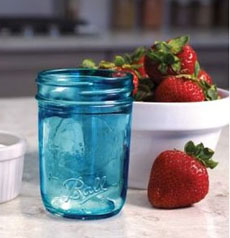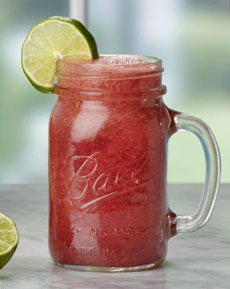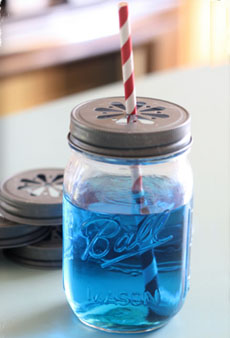TIP OF THE DAY: 21st Century Uses For Ball Jars

|
Whether you call them Ball jars, Kerr jars, Mason jars or some other name, canning jars, a 19th century product, have been repurposed in the 21st. (See the history below.) First, there’s a color version—blue—in both the three sizes of jars, and color-banded lids. The blue jars join the limited edition green and purple jars. Both products—jars and lids—are sold separately. They join other recent product innovations: Fans have come up with the most ingenious uses to repurpose Mason jars, from liquid soap dispensers to smartphone speakers. After-market hardware is manufactured to create them—that’s how many people repurpose Mason jars. But for us everyday folks, beyond canning there are: Food Uses The first can was a glass jar. We take canned food for granted, but it is a relatively recent invention—and we owe it to Napoleon Bonaparte. In his time (1769-1821), food preservation was limited to salting, drying and pickling, techniques that had existed for thousands of years. Needing a better solution for his troops, in 1795 the French general, known for declaring that “an army marches on its stomach,” got the French government to offer 12,000 francs to anyone who invented a new way to preserve food. The prize was ultimately won by Nicholas Appert, a chef, confectioner and distiller, who began experimenting when the award was announced and finally submitted his invention 14 years later, in 1809. Appert hermetically sealed food in airtight glass jars and heated them—a method similar to today’s home preserving in Mason jars. Appert thought that driving the air out of the containers prevented the spoilage, but 100 years later, Louis Pasteur showed that it was the elimination of bacteria through sterilization that did the trick. Napoleon tried to keep the new process a secret so that enemy armies would not have the advantage, but the word leaked out. Appert’s method was so easy that it quickly became widespread. Appert, who also invented the bouillon cube, became known as the “father of canning.” The following year another Frenchman, Pierre Durand, patented a method using a tin container. The lighter, breakage-proof tin cans would become the norm for commercial use, although homemakers, lacking canning equipment, continued to use the jars. In 1812, an English company purchased both patents and began producing canned preserves. While canning crossed the ocean to America and canneries began to preserve seasonal foods and perishables, most Americans still cooked with fresh and dried staples—plus whatever they “put away” in Mason jars. Canned food did not become the everyday food delivery system we rely on until the beginning of the 20th century. |
|
|
The Invention Of The Mason Jar In 1858, the first Mason jar was designed and patented. Philadelphia tinsmith John Landis Mason developed the jar specifically to withstand the high temperatures necessary for sterilizing pickles. He received a patent in 1858, but ultimately sold his rights and never enjoyed the financial rewards of his invention. Today the Ball and Kerr brands are manufactured in the U.S. by Jarden Corp. Here’s a more detailed history. Currently, the history of the Mason jar ends with the wane of home canning. The growth of the artisan food movement helped sales, but on a small scale. Ball pursued expanding the use of the jars for 21st-century consumers. The result: today’s fashion of serving drinks and food in the jars—and jars and lids adapted for those purposes. What’s next? We eagerly await the news. |
||



